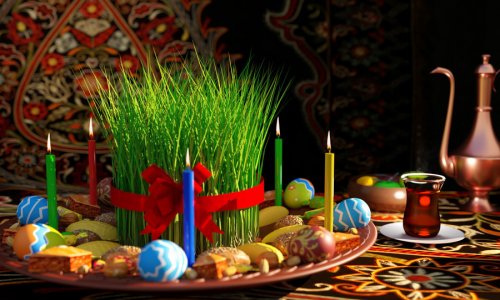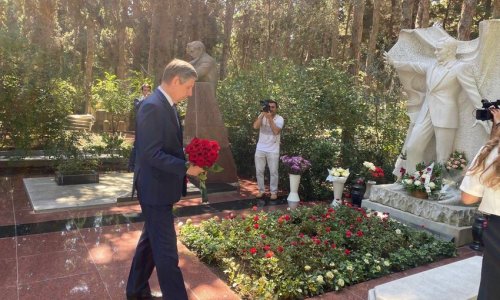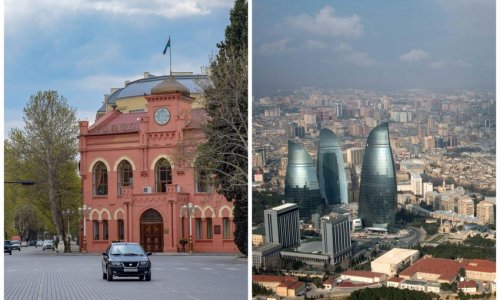By MEGAN CONWAY
The Wall Street Journal
ON THE SECOND FLOOR of Yay contemporary art gallery, a two-story sandstone structure in Baku, the artist Faig Ahmed is peeling bubble wrap off several medium-size carpets hung in frames. The top half of one rug resembles the centuries-old weaving tradition that's helped make his native country, Azerbaijan, famous across the Caucasus. Outside, vendors are hawking similar patterns to tourists in the Ichari Shahar, or Old City, a nest of cobbled streets, mosques and caravan stops at the capital's medieval center. In 2000, the entire walled area was designated a UNESCO World Heritage Site, though gazing toward the palace of the Islamic Shirvanshah dynasty—the gallery's terrace overlooks the ruin of the royal hammam—one can also see the 600-foot Flame Towers arcing up from the hills ringing the city, three curvilinear structures outfitted with 10,000 LED lights that blaze, at night, like enormous licks of fire.
Ahmed, 31, has a pointy beard and almond-shaped eyes. Scanning down the carpet, something interesting begins to happen. Each decorative flourish—ancient symbols, he explains, for horses, birds, dragons—begins to pixilate and then dissolve into blurred blocks of color. The artwork turns out to be a clever deconstruction of traditional craft, incorporating digital disruption into the literal fabric of its design. (Ahmed spent months finding artisans who would undertake the laborious process of hand-weaving his tradition-meets-tech designs.) With its provocative blend of rich historicism and hyper modernity, the carpet is also a potent symbol of Baku itself. Pointing at the rug, he says, "There are some things we are used to seeing, and when they change you can feel how strange it is—suddenly, change is here."
Azerbaijan's ancient capital curves along a crescent-shaped bay on the Caspian Sea. If the country has a single defining characteristic, it's an ability to harmoniously absorb diverse cultural influences. Its tangled traffic is comprised of Soviet-make Ladas, Mercedes S-Classes and purple London-style taxis nicknamed "aubergines." Women like to wear their hair waist-length while men opt for western jeans paired with traditional flourishes: a beard, a skullcap, prayer beads. (Like its southerly neighbor, Iran, the country is predominately Shia Muslim.) Baku's spate of recently opened luxury shops—Céline, Dior, Tom Ford —are clustered along a waterfront byway called Neftchilar Avenue that's also home to fin de siècle oil-boom mansions, Soviet government buildings and an imposing 12th-century stone landmark known as the Maiden Tower.
Situated at the base of the Caucasus Mountains, Azerbaijan has been conquered over the millennia by Alexander the Great, the Mongols, the Ottomans, the Persians and the Russians. It has been squeezed between East and West, old and new, Islam and Christianity, Europe and Asia for so long that to say it exists at a cultural crossroads—as people have for centuries—is to resort to cliché.
Only during its very recent history has Azerbaijan's cross-cultural flourishing been put on hold. In 1991, along with most of the former USSR, Baku emerged from more than 50 years of repressive communist rule, an era that replaced the city's syncretic broadmindedness with monolithic totalitarianism. Since the thaw—and for the second time in its long history—Azerbaijan has been applying its petro dollars to become an economic engine for the region. Its cultural capital is rising, too.
Ruled for the past decade by President Ilham Aliyev, who inherited the presidency from his father Heydar Aliyev, the current government has been accused of corruption, holding unfair elections and limiting free speech. "Unfortunately, corruption exists in every society around the world and the government of Azerbaijan is making every effort to address this problem in Azerbaijan," says Fakhraddin Ismayilov, press attaché at the Embassy of the Republic of Azerbaijan.
It's impossible to overstate the importance of oil to Azerbaijan. At the turn of the last century, when Baku's population growth outpaced that of London and New York, the city was a heady blend of European metropolis and Wild West frontier. It was known for its Philharmonic Hall, inspired by Monte Carlo's grand casinos, which housed the first opera house in the Muslim world. The Rothschilds and the Nobel brothers built opulent mansions underwritten by fortunes made from Azeri oil, as did dozens of Muslim "oil barons," who aspired to transform Baku into the grandest city in the Islamic world through civic philanthropy. As the writer Tom Reiss details in The Orientalist, Azerbaijan thought of itself as Europe's easternmost outpost—even if the rest of Europe didn't necessarily know it. "Even today it is possible to imagine that one has wandered into some unusually sooty Right Bank neighborhood in Paris, mysteriously abandoned by its inhabitants," writes Reiss.
Though efforts to restore the country to its pre-Soviet stature began immediately after the Iron Curtain lifted, the pace of regeneration has hit warp speed in the last few years. On the one hand, the government is pouring millions of dollars into civic improvements, much of it tellingly centered on cultural infrastructure like the recently opened Zaha Hadid–designed Heydar Aliyev Center. The concert hall and exhibition space resembles a swooping space-age Bedouin tent perched on a hill, its sinuous design a reference to Islamic calligraphy. There's also the soon-to-open relocation of the State Museum of Azerbaijan Carpet and Applied Art, the design of which evokes a massive rolled-up rug.
While architectural pyrotechnics like the HOK-designed Flame Towers and the Heydar Aliyev Center—both completed in 2012—serve as bids for international attention, the not-for-profit arts organization Yarat is the force behind the city's nascent but fast-growing contemporary art scene. Since its founding in September 2011, Yarat has produced an astounding 42 projects, from "Love Me, Love Me Not"—a special pavilion at the 55th Venice Biennale of art from countries that share a border with Azerbaijan, including Iran, Turkey, Russia and Georgia—to a site-specific exhibition of 29 emerging artists housed inside the Baku Air Condition Plant. It has produced a pop-up film festival; collaborations with galleries in New York, Paris and London; and an annual Public Art Festival that last year brought the Dutch artist Florentijn Hofman's giant globe-trotting rubber ducky, previously moored in Hong Kong's Victoria Harbour, to Baku.
"The idea was to have a group of artists who support each other, a platform that puts everyone together," says Yarat's founder, Aida Mahmudova, who plans to move Yarat's current headquarters in the Old City to a multistory former Soviet naval base in 2015. "You gather, and it's power already."
Part of Yarat's mandate is to promote Azerbaijani artists internationally as well as at home. In September 2012, it helped organize the first Christie's exhibition in Baku. "It was a combined exercise which showcased international art alongside a very vibrant local art scene," says Paul Hewitt, managing director of growth markets at the auction house. "It was an important first step of a developing relationship." Held at the Four Seasons, one of several brand-new five-star hotels in the capital, the show featured works by Picasso, Warhol and DeLempicka and was attended by a troop of high-powered collectors from Mexico, China, Switzerland and India—a bellwether for a city on the verge of becoming an art-world destination for the private jet set. At the same time, Yarat opened the exhibition "Commonist," with works by its artists, including Ahmed and 18 others.
AT THE CENTER of this transformation is Mahmudova, a 32-year-old with a slight gym-toned frame and a broad smile who has become the link between official culture and subculture in Baku. Her aunt Mehriban Aliyeva is the country's first lady. Her cousin Leyla Aliyeva (Mehriban's daughter) is the editor-in-chief of the Condé Nast–owned Baku magazine, a glossy dedicated to all things luxurious in the capital. "The idea [for Yarat] came to me a long time ago, way before I founded the organization," she says. With her familial wealth and desire to help artists of all generations, she approximates a very young, very glamorous godmother of art.
Mahmudova is herself a commercially successful artist. After earning a degree in fashion merchandising from the American InterContinental University, she studied painting at London's prestigious Central Saint Martins. She says her time in the British capital shaped her sense of how an arts organization in Baku might be structured. But it wasn't until after she'd finished school in London, married an Iranian entrepreneur and had a daughter, now 3 years old, that she focused her energies on getting the organization off the ground.
Moving back to Baku in 2010, she became close with other young artists—such as Ahmed and Farid Rasulov, who creates life-size installations out of carpets and surreal plastic animals. Together, they realized there was no single organization in Baku for artists looking to show work or collaborate—much less gain international traction. Furthermore, any such organization would have to actively generate a homegrown audience for the kinds of abstract or conceptual art they make, which looks radically unfamiliar to most Azerbaijani eyes. "I wouldn't call it a plan," she says of Yarat's early days. "It was a dream and a passion and then it turned into a reality. It was spontaneous, based on an emotional level. Now, of course, we make plans two or three years ahead of time."
"I think I'm really at the right place at the right time," she adds. "The whole country is emerging, for the West especially. It's opening up and it's growing, and Yarat is growing at the same time."
Though she surely benefits from her family connections, Mahmudova is not involved in politics—and given the controversy surrounding her aunt's husband, she has every reason to downplay her political connections. She structured Yarat as a not-for-profit, with a creative board made up of artists. Money is raised by petitioning local businesses like banks and telecommunications companies for support, typically for specific projects, like the Public Art Festival, a citywide event that lasts six months and showcases several dozen works of art. Yay gallery serves as the commercial wing of the organization, with half of the profits going to the artist and the other half to Yarat, which employs seven people full time.
Last December, Yarat held its first general fund-raiser, a presentation followed by cocktails at the JW Marriott Absheron hotel. According to Davud Gambarzade, Yarat's international program director, Azerbaijani companies are beginning to recognize that being associated with the arts can have a positive branding effect. Money that once went to chess competitions or sports like wrestling—both popular in Azerbaijan—is now funding artistic patronage.
In 2012, for the Public Art Festival, Mahmudova made an artwork installed in the Seaside Boulevard, a landscaped promenade that runs between the Caspian Sea and Neftchilar Avenue. The work is derived from the ornate window frames of an abandoned building across the avenue. Mahmudova rescued the frames and repurposed them in a fragmented, paisley-like pattern, replacing the glass with reflective material. The artwork, called Recycled, now shows a splintered version of the new Baku. "Four years ago, I wasn't changing as fast as I'm changing now. Everything was slower. It's crazy. And it's difficult," says Mahmudova. "Sometimes I don't like the fast changes, even inside myself—but I can't help it because I change my surroundings and my surroundings change me."
In 2013, Mahmudova was appointed curatorial director of the four-year-old Baku Museum of Modern Art. Next year, she plans to narrow the scope of its rotating exhibition space to focus on Azerbaijani artists, particularly emerging ones, like the 34-year-old painter Rashad Babayev. Babayev's large-scale canvases use color and shadow to create powerful abstract forms. Schooled as a lawyer, he considers himself "street educated" by an older generation of artists such as Rasim Babayev (no relation), a Soviet-era painter whose politically provocative work became nationally recognized only after his death. "I spent a lot of time speaking with the artistic community, talking with other artists, so I have a kind of training," says Rashad Babayev. He has been working with Yarat since its inaugural group exhibition, "On Soz"—meaning "forward" in Azeri.
The museum is perhaps the least ostentatious example of Baku's drive to build blue-chip architecture. Though the city's construction frenzy draws comparisons to Dubai and Abu Dhabi, Bakuvians recoil at the implications: Where those Emirate cities often import a kind of rootless western architecture, Baku's structures reference the country's cultural heritage. Even the glittering Flame Towers are a nod to the country's past as a spiritual center for Zoroastrians—practitioners of Persia's pre-Muslim religion, who were drawn to the flames that still spontaneously erupt from the landscape thanks to natural gas leaks.
Gas is unavoidable in Azerbaijan. The world's first mechanized rig struck big here in 1871, and by 1901 the country's fields pumped half the world's crude. The most powerful gushers were given names, such as Wet Nurse and Golden Bazaar. During Soviet rule, the industry languished, but in 1994, Heydar Aliyev signed the so-called Contract of the Century, a series of deals with multinational energy companies that paved the way for Azerbaijan's offshore oil fields to be developed, and returned vast, if unevenly distributed, wealth to the county. The opening of the Baku-Tbilisi-Ceyhan pipeline in 2006 and a gradual shift in resources from oil to natural gas are helping to keep the industry strong. Early this year, Yay gallery showed a series of paintings called Girls Prefer Oilmen by the Russian-born painter Irina Eldarova. The works depict candy-colored versions of Marilyn Monroe demurely flirting with Azerbaijani rig workers.
THE AVERAGE ART STUDENT in Baku will graduate with excellent technical skills, learning to sculpt from life or paint in the Soviet Realist style that still dominates academic art. What's not on offer, however, is the kind of conceptual art that most western schools have favored over the last 50 or so years—art that considers process and ideas and may not even look like art to someone outside the field.
Yarat tries to address some of these gaps through its educational initiative, Artim ("progress" in Azeri). Artim offers workshops, lectures and master classes that are open to the public. "We try to add something that's missing," says Mahmudova. "Photographers have to take workshops outside of university, so we teach that." Yarat also hosts international artists residencies, luring working artists and professors from institutions like the Wimbledon College of Art and the Royal College of Art in London. Last November, Mark Dunhill, the dean of art at Central Saint Martins, held a four-day sculpture workshop at the arts academy with his partner, Tamiko O'Brien. "What I think is good about the Yarat foundation is that they are really serious about education and trying to bring about change through changing the way people think about things," says Dunhill. "Culture is a powerful force, and while it may not be overtly political, I think that encouraging people to open their eyes to different ways of seeing things is good, and I'm keen to support that."
There have been unmistakable successes for Yarat: The Venice pavilion; "Fly to Baku," a traveling exhibition of Azerbaijani artists' work co-organized by the high-profile Swiss auctioneer Simon de Pury ; "Merging Bridges," a 2012 show at the Baku MoMA of work by Yarat-supported artists and international names like James Turrell, Idris Khan and Olympia Scarry; and Ahmed, who last year was short-listed for the Victoria and Albert Museum's Jameel Prize 3 for artists inspired by the Islamic tradition. This month, the exhibition "Love Me, Love Me Not," which includes work by New York–based Ali Banisadr and the international collective Slavs and Tatars, travels from Venice to the Heydar Aliyev Center's tiered galleries. At the same time, Yarat will travel to Art Dubai as part of its Marker section, focused this year on Central Asia and the Caucasus.
One chilly afternoon, Mahmudova visits the crumbling three-story studio space she shares with Ahmed, Rasulov and other friends. "I'm just very tired constantly because we've been working so hard for the past two years," she says. There are dark stains on the floor where rainwater has overflowed from wineglasses placed beneath leaks in the skylight. Canvases tilt against the graffiti-covered walls. The voice of a man reciting passages of the Koran drifts up from the street outside, where a Muslim funeral is taking place.
This is an older, less gentrified section of Baku, where the streets are narrow and difficult to navigate. Mahmudova doesn't come here very often anymore. She's set up a studio in her apartment across town, where she can paint in the evenings when the mood strikes her and see her daughter anytime. It's just as well. Soon, much of the neighborhood will succumb to modernization, making way for a new highway or parkland or gleaming office towers—monuments to Azerbaijan's future.
ANN.Az











